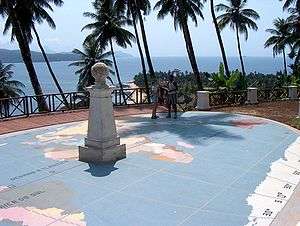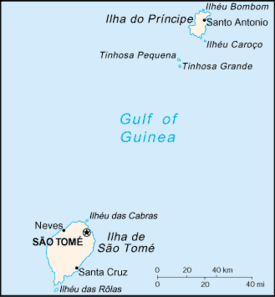Ilhéu das Rolas
|
Map of São Tomé and Príncipe | |
| Geography | |
|---|---|
| Location | São Tomé and Príncipe |
| Coordinates | 0°00′14″S 6°31′21″E / 0.003777°S 6.522388°ECoordinates: 0°00′14″S 6°31′21″E / 0.003777°S 6.522388°E |
| Administration | |
| Demographics | |
| Population | 200 |
Ilhéu das Rolas is an islet in São Tomé and Príncipe, in Africa. The island lies on the equator, off the southern tip of São Tomé Island separated by Canal das Rolas. It is in the Caué District of São Tomé Province. The island is home to a small resort, the Pestana Equador.
Population history
| Historical population | ||
|---|---|---|
| Year | Pop. | ±% |
| 2001 (census) | 224 | — |
| 2008 (estimate) | 296 | +32.1% |
About the islet

The main and dominant economic activity is tourism, related mainly to the resort. A permanent population of approximately 200 people works in the island's tourism sector. The center of the settlement may be the closest to the Equator on the planet.
The island can only be accessed by boat departing from São Tomé Island.
Much of the southern part is in the Southern Hemisphere, its total area of that portion covering over 80% of the island covers 5 square kilometres (1.9 sq mi) of the islet and only less than 1% of the nation. The island has a small geyser named Furnas. Numerous beaches dominates including one by the resort, Santo António and Café.
The islet also has a lighthouse (better as Ilhéu das Rolas and not Gago Coutinho), it was built in 1929, over a decade after the completion of the monument. As it sits on a hill, its focal height is 106 meters and its range is about 20 km (12 nmi). It is located in the Northern Hemishpere and is not far from the opposite hemispere.[1]
Confirmation of equatorial position
Gago Coutinho (1869–1959), officer of the Portuguese Navy, navigator and historian, headed a geodesic mission to São Tomé between 1915 and 1918, when marks were placed as a basis for a geodetic network in the archipelago. After that, observations for triangulation, precise base measurement and astronomical observations were made.
In the process, Gago Coutinho proved that Ilhéu das Rolas is crossed by the equatorial line. The resulting map was published in 1919, together with the Report of the Geodetic Mission on São Tomé Island 1915–1918, that was officially considered the first complete work of practical geodesy in the Portuguese colonies.
Gallery
 Furnas in Rolas
Furnas in Rolas.jpg) Strand Santo António
Strand Santo António Ilhéu das Rôlas, STP
Ilhéu das Rôlas, STP Resort Pestana Equador
Resort Pestana Equador
References
- ↑ "Sao Tome & Principe". ARLHS World of Lights (WLOL). Amateur Radio Lighthouse Society. April 8, 2009. Retrieved 4 May 2017.
Further reading
| Wikimedia Commons has media related to Ilhéu das Rolas. |
- Great World Atlas, Reader´s Digest Selections, 1st ed, September 2006, p. 223. ISBN 972-609-471-2
- Grande Dicionário Enciclopédico Ediclube Vol. XVI, p. 5574 e 5575. 1996. ISBN 972-719-056-1

